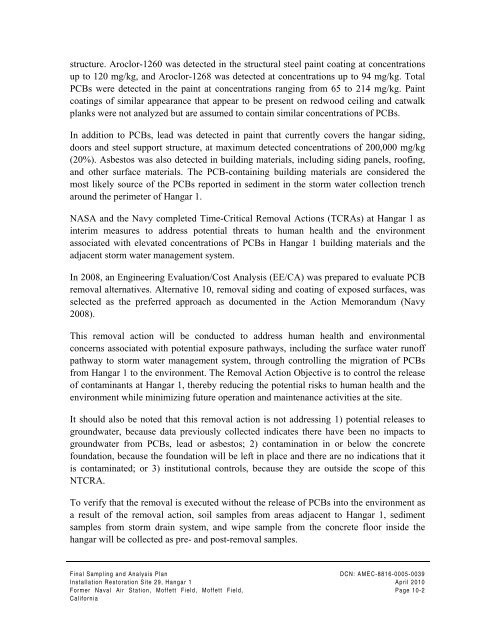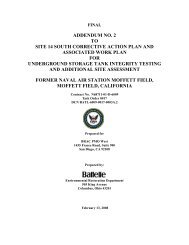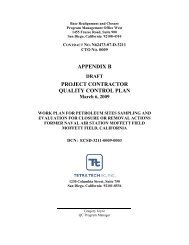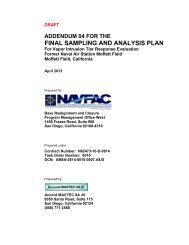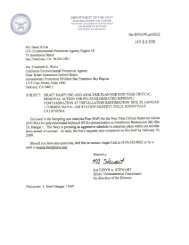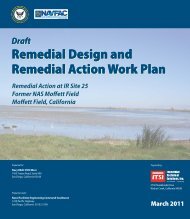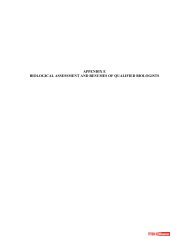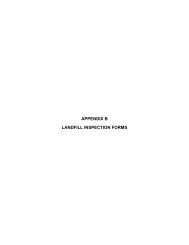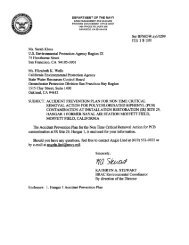FINAL SAMPLING AND ANALYSIS PLAN - Documents for Moffett Field
FINAL SAMPLING AND ANALYSIS PLAN - Documents for Moffett Field
FINAL SAMPLING AND ANALYSIS PLAN - Documents for Moffett Field
Create successful ePaper yourself
Turn your PDF publications into a flip-book with our unique Google optimized e-Paper software.
structure. Aroclor-1260 was detected in the structural steel paint coating at concentrations<br />
up to 120 mg/kg, and Aroclor-1268 was detected at concentrations up to 94 mg/kg. Total<br />
PCBs were detected in the paint at concentrations ranging from 65 to 214 mg/kg. Paint<br />
coatings of similar appearance that appear to be present on redwood ceiling and catwalk<br />
planks were not analyzed but are assumed to contain similar concentrations of PCBs.<br />
In addition to PCBs, lead was detected in paint that currently covers the hangar siding,<br />
doors and steel support structure, at maximum detected concentrations of 200,000 mg/kg<br />
(20%). Asbestos was also detected in building materials, including siding panels, roofing,<br />
and other surface materials. The PCB-containing building materials are considered the<br />
most likely source of the PCBs reported in sediment in the storm water collection trench<br />
around the perimeter of Hangar 1.<br />
NASA and the Navy completed Time-Critical Removal Actions (TCRAs) at Hangar 1 as<br />
interim measures to address potential threats to human health and the environment<br />
associated with elevated concentrations of PCBs in Hangar 1 building materials and the<br />
adjacent storm water management system.<br />
In 2008, an Engineering Evaluation/Cost Analysis (EE/CA) was prepared to evaluate PCB<br />
removal alternatives. Alternative 10, removal siding and coating of exposed surfaces, was<br />
selected as the preferred approach as documented in the Action Memorandum (Navy<br />
2008).<br />
This removal action will be conducted to address human health and environmental<br />
concerns associated with potential exposure pathways, including the surface water runoff<br />
pathway to storm water management system, through controlling the migration of PCBs<br />
from Hangar 1 to the environment. The Removal Action Objective is to control the release<br />
of contaminants at Hangar 1, thereby reducing the potential risks to human health and the<br />
environment while minimizing future operation and maintenance activities at the site.<br />
It should also be noted that this removal action is not addressing 1) potential releases to<br />
groundwater, because data previously collected indicates there have been no impacts to<br />
groundwater from PCBs, lead or asbestos; 2) contamination in or below the concrete<br />
foundation, because the foundation will be left in place and there are no indications that it<br />
is contaminated; or 3) institutional controls, because they are outside the scope of this<br />
NTCRA.<br />
To verify that the removal is executed without the release of PCBs into the environment as<br />
a result of the removal action, soil samples from areas adjacent to Hangar 1, sediment<br />
samples from storm drain system, and wipe sample from the concrete floor inside the<br />
hangar will be collected as pre- and post-removal samples.<br />
Final Sampling and Analysis Plan<br />
Installation Restoration Site 29, Hangar 1<br />
Former Naval Air Station, <strong>Moffett</strong> <strong>Field</strong>, <strong>Moffett</strong> <strong>Field</strong>,<br />
Cali<strong>for</strong>nia<br />
DCN: AMEC-8816-0005-0039<br />
April 2010<br />
Page 10-2


